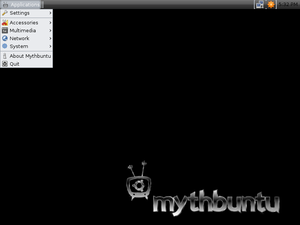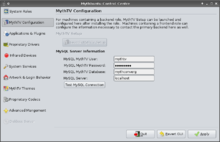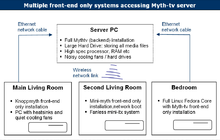- Mythbuntu
-
Mythbuntu 
Mythbuntu 8.04.1OS family Unix-like Latest stable release 11.10 / October 13, 2011 Official website mythbuntu.org Mythbuntu is a media center operating system (OS). It is based on Ubuntu and integrates the MythTV Media center software as its main function, and does not install with all of the programs included with Ubuntu.
Following the principles of KnoppMyth and Mythdora, Mythbuntu is designed to simplify the installation of MythTV on a home theater PC. After Mythbuntu has been installed the MythTV setup program begins in which it can be configured as a frontend (a media viewer), backend (a media server), or combination of the two.
Mythbuntu aims to keep close ties with Ubuntu thus allowing changes to be moved upstream for the greater benefit of the Ubuntu Community.[1] Due to the close link with Ubuntu, easy conversions between desktop and standalone Mythbuntu installations are possible. The development cycle of Mythbuntu closely follows that of Ubuntu, with releases occurring every six months.[2]
Contents
Desktop
Mythbuntu uses the Xfce desktop interface by default, but users can install ubuntu-desktop, kubuntu-desktop, or xubuntu-desktop through the Mythbuntu Control Centre, allowing users to get the default interfaces from those flavors of Ubuntu. The only software that is included in this release is media-related software such as VLC, Amunix, and Rhythmbox.
Mythbuntu Control Centre
The Mythbuntu Control Centre provides a GUI which can be used to configure the system. The user can select what kind of system (Backend, Frontend, Both) they wish to have installed. Inside the Control Centre, the user can perform common actions such as installing plugins for MythTV, configuring the MySQL database, setting passwords, and installing drivers and codecs. Configuration of remote controls and a range of other utilities and small programs are performed all from within this program.
Different Applications of Mythbuntu
Complete Installation (Front-end and Back-end)
Mythbuntu can be used to install a full MythTV system on a single device (acting as both client and server). The front-end is the software required for the visual elements (or the GUI) and is utilised by the common user to find, play, and manipulate media files. The backend is the server where the media files, tuners, and database are actually stored. A full frontend and backend system may have an advantage in that it has 'portability', i.e. it is a standalone device that is not dependent on a separate server (like a gaming console for example).
Front-end only installations
Alternatively, Mythbuntu can be used to install a MythTV client, front-end only system. For example, users may have a central storage device (server) in their home that can be accessed from numerous other devices throughout the home over a network. The central storage device can act as MythTV server, and the MythTV front-end client software can be installed on devices containing minimal hardware. Mythbuntu can also run directly from a CD-ROM (i.e. without installation), providing that there is a network connection to a PC with a 'complete installation' (a MythTV back-end server).
Using a 'server' separate from one or more front-end units offers the advantage of providing multiple clients with simultaneous access to a single repository of shared media files. The server used would generally have hardware of a relatively high specification and can be kept outside of the main living room or other entertainment area of the home. An advantage of keeping the server PC outside the living room is that some configurations can be quite noisy (especially with certain hard drives or server power supply fans), and it can be expensive to invest in fanless/heat sink equipment to avoid such noise problems.
Adding Mythbuntu to Ubuntu
Mythbuntu is an Ubuntu derivative that offers an easy single-click conversion from Ubuntu to Mythbuntu[1][3]. This means a user no longer needs to type in command line, which can be daunting to new users, or hunt for packages in the various package managers.
Version history
- Mythbuntu 7.10 Gutsy Gibbon (with MythTV .20) was released on Monday, October 22, 2007.
- Mythbuntu 8.04.1 Hardy Heron (with MythTV .21) was released Monday July 14th, 2008.
- Mythbuntu 8.10 Intrepid Ibex (with MythTV .21) was released on Thursday Oct 30th, 2008.
- Mythbuntu 9.04 Jaunty Jackalope (with MythTV .21-fixes) was released on Thursday April 23rd, 2009.
- Mythbuntu 9.10 Karmic Koala (with MythTV .22) was released on Thursday October 29th, 2009.[4]
- Mythbuntu 10.04 Lucid Lynx (with MythTV .23) was released on Thursday April 29th, 2010.[5]
- Mythbuntu 10.10 Maverick Meerkat (with MythTV .23.1) was released on October 19, 2010.[6]
- Mythbuntu 11.04 Natty Narwhal (with MythTV .24) was released on April 28, 2011.[7]
See also
References
External links
Ubuntu General - Canonical Ltd.
- Contributor agreement
- Releases
- Ubuntu (philosophy)
- Ubuntu Foundation
People Official derivatives - Edubuntu
- Gobuntu
- Kubuntu
- Lubuntu
- Mythbuntu
- Ubuntu JeOS
- Ubuntu Mobile
- Ubuntu Netbook Edition
- Ubuntu Server
- Ubuntu Studio
- Xubuntu
Unofficial derivatives - EasyPeasy
- Fluxbuntu
- gOS
- gNewSense
- Linux Mint
- Nexenta OS
- Super OS
- more…
Software and support - Ask Ubuntu
- Bazaar
- GetDeb
- GDebi
- Launchpad
- Medibuntu
- Nautilus
- OpenCD
- Paper Cut
- Personal Package Archive
- Software Center
- Restricted extras
- Ubiquity
- Ubuntu Certified Professional
- Ubuntu One
- Uncomplicated Firewall
- Unity
- Update Manager
- Upstart
- Usplash
- Wubi
- XSplash
Fonts - Ubuntu Font Family
- Ubuntu-Title
Media - Full Circle Magazine
- OMG! Ubuntu!
- Ubuntu User
Related software - Debian
- deb format
- dpkg
- APT
- aptitude
- debconf package
- dash
Linux distributions Arch Linux · CentOS · Debian · Fedora · Gentoo · Knoppix · Linux Mint · Mandriva Linux · Red Hat Enterprise Linux · Slackware · SUSE · Ubuntu · more…Operating systems that offer the Xfce desktop ALT Linux · Arch Linux · Debian · Dreamlinux · Dyne:bolic · Element OS · Fedora · FreeBSD · FreeSBIE · Gentoo Linux · Granular Linux · KateOS · Linpus Linux · Linux From Scratch · Linux Mint · Mandriva Linux · Mythbuntu · openSUSE · PC/OS · Puredyne · Salix · Sam Linux · sidux · Slackware · Slax · SystemRescueCD · SuperGamer · VectorLinux · Wolvix · Xubuntu · Zenwalk · ZevenOS
Home theater PC software and related devices Windows Beyond TV · GB-PVR · Meedio · MediaPortal · J. River Media Center · ShowShifter · Windows Media Center · XBMCMac OS X Linux Cross-platform Set-top boxes/
Digital media receiversApple TV · DBox2 · Dreambox · HP MediaSmart Connect · Hauppauge MediaMVP · Google TV · Netgear Digital Entertainer · Roku · TiVo · Vu+ · WD TV · Windows Media Center ExtenderRelated hardware ATI Theater Cards · Elgato EyeTV devices · Hauppauge Computer Works WinTV PVR Cards · HDHomeRun · Remote control (Touchscreen) · Mac Mini · Nvidia TV-Tuner Cards · Quiet PCSystem manufacturers Alienware · Apple Inc. · Dell · Gateway · Hewlett-Packard · Intel · Logitech · Interact-TV · Shuttle Inc. · Sony (VAIO series) · Toshiba · Velocity Micro · Zotac ·Related articles Categories:- Ubuntu (operating system) derivatives
- Multimedia software
- Free television software
Wikimedia Foundation. 2010.


